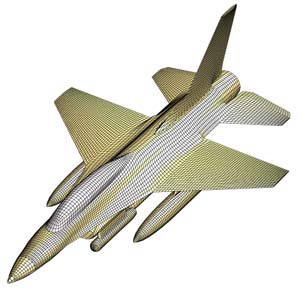Latest News
May 25, 2010
By DE Editors
 |
XYZ Scientific Applications, Inc. is planning to release an automatic structured all quadrilateral shell mesh generation feature called AutoQuad late in 2010. Of course there are many products on the market that offer automatic shell mesh generation. But the new TrueGrid AutoQuad has some unique features that make building a high quality all quadrilateral mesh easy. In particular, the projection method is used so that the quality of the mesh is not influenced by the way the geometry is rather arbitrarily split up by the CAD or solids modeler. This is explained below. Also, AutoQuad produces block structured meshes with the minimum number
of irregular nodes while maintaining mesh on the boundary. This is also explained below in greater detail.
The process of building the all quadrilateral mesh is quite simple. After selecting the AutoQuad mesh option, select the surface using the mouse in the picture. If a set of surfaces are to be meshed with one mesh, it is necessary to first use the option to form a composite surface. A composite surface is easy to form by simply selecting a set of surfaces with the mouse. This may sound trivial but is, in fact, quite significant. You are not required to mesh each surface and then try to equivalence the boundaries of each surface with the boundaries of its neighboring surfaces. This would require that the surfaces be nearly perfectly matched along their boundaries. This is not realistic with today’s solids modelers. By forming a composite surface in TrueGrid, you can avoid these complications. TrueGrid forms the mesh and projects it, using TrueGrid’s tried and true projection method, to the composite surface as though it were a single surface.
The next step is to select the nodal distribution along the boundary of the surface. This can be as easy as choosing the number of nodes or the size of the edges between nodes. There is a rich selection of additional options for boundary selection and nodal distribution.
Then click on the mesh button. If you do not like what you see, you can modify your boundary of nodal distribution choices and try again. Loads, boundary conditions, contact surfaces, and sets can then be applied to this mesh.
A new technique has been developed for the TrueGrid AutoQuad feature that chooses the best multi block topology based on the shape of the boundary of the region to be meshed. The best topology is the one that has the fewest number of irregular interior nodes. A regular interior node is one that is connected to 4 quadrilaterals. An irregular node is one that is connected to 3 quadrilaterals or it is one that is connected to more than 4 quadrilaterals. Irregular nodes can be the source of some of the greatest numerical errors in a simulation. By keeping the number of these types of nodes to a minimum, one can reduce the numerical errors in the simulation. However, in most cases, it is impossible to eliminate all irregular nodes without producing a bad mesh at the boundary, so some irregular nodes should be expected for all but the simplest of mesh problems.
Subscribe to our FREE magazine, FREE email newsletters or both!
Latest News
About the Author
DE’s editors contribute news and new product announcements to Digital Engineering.
Press releases may be sent to them via [email protected].






